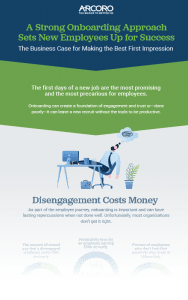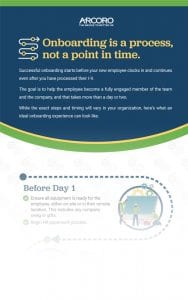Hiring and employee onboarding processes have consistently been areas HR looks to improve. After all, employees are the backbone of any company. But if you haven’t taken steps to make some positive changes, your company may not be well positioned for current and future labor force challenges. A report by Korn Ferry predicts by 2030, more than 85 million jobs could go unfilled because there aren’t enough skilled workers to take them. The trend has already started, made worse by challenges associated with the pandemic. What’s more workforce shortages are being felt right here, right now—not years down the road or in some other part of the world.
Arcoro recently conducted an informal poll of 350 HR professionals across multiple industries to ask about their current hiring efforts. What we found is that the majority need to fill positions, both locally and remotely.
What is the hiring focus at your company?
- We have many positions that we need to fill locally – 52%
- We have many positions to fill either local or remote – 24%
- We have a few positions to fill either local or remote – 20%
- We aren’t adding new employees now but we will in 2022 – 4%
With so many companies needing to fill positions, employee onboarding processes must be effective and engaging. If not, the employee you just worked so hard to hire might jump ship. According to a survey by CareerBuilder, 88% of employees don’t feel their employer was great at onboarding and 9% have left a company due to poor onboarding. That’s why getting off to a good start with new hires is so important.
Our survey respondents said they welcome new employees in a variety of ways.
How do you welcome your new employees?
- Take them to lunch – 34%
- Assign them a buddy – 33%
- Send or give them company swag – 48%
- Announce their arrival to the entire company – 65%
- Set expectations on the first day – 71%
A warm welcome creates a good foundation for the employer/employee relationship. But onboarding shouldn’t end after the first day. Employee onboarding involves more than filling out day one paperwork (W2s, I9s, direct deposit, etc. It should be an ongoing process that gives new employees all the tools they need to do their job effectively. According to SHRM, onboarding is a comprehensive process involving management and other employees and can last up to 12 months. Many companies are falling way short of 12 months, with most focusing on offering new hires just a month of onboarding. Less than 10% of the companies we polled focused on onboarding after 90 days.
How long does your employee onboarding program last?
- One day – 28%
- One week – 30%
- One to three months – 35%
- Three to five months – 4%
- Six months to a year – 4%
Onboarding shouldn’t be confused with orientation. It needs to include a complete training program that will give new hires the confidence to do their jobs effectively, along with integrating them into your company, their teams and the overall culture. Employers can take several different avenues to get the job done, but doing nothing can have serious negative consequences and may cost you hard-won new employees.
How do you create your training strategy for the year?
- Each manager creates a job-specific training program – 46%
- We do training during onboarding – 28%
- Our training plan cascades from company goals – 29%
- Not sure or we don’t have one – 26%
Your onboarding process is absolutely essential for introducing new employees to your company, their position and their teammates but also for engaging them from day one. Don’t skimp on this process or think it just includes filling out paperwork. A thorough employee onboarding that also includes a warm welcome, training and even team building can provide that necessary strong foundation your employees need to grow with your company.
Arcoro offers onboarding software that helps employers make sure all necessary steps are taken. Learn more by reading the resources below then when you’re ready, schedule a demo to see for yourself how onboarding software can help you up your game.
 Start with this look at the importance of a strong onboarding approach: A Strong Onboarding Approach Sets New Employees Up for Success.
Start with this look at the importance of a strong onboarding approach: A Strong Onboarding Approach Sets New Employees Up for Success.
Then discover the secret to creating the ideal onboarding process: Onboarding is a Process. 




